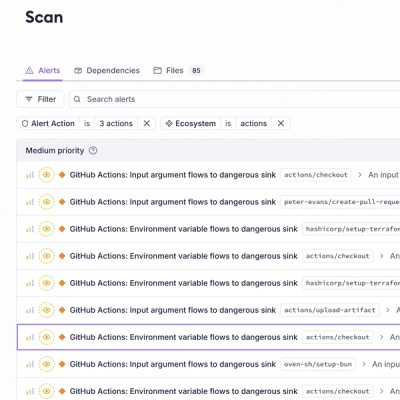
Product
Introducing Socket Firewall Enterprise: Flexible, Configurable Protection for Modern Package Ecosystems
Socket Firewall Enterprise is now available with flexible deployment, configurable policies, and expanded language support.
This is a weird obfuscated network protocol that was originally meant to be part of a VPN. It was designed with the existence of advanced DPI in mind and is meant to be as difficult to identify as possible.
Yep. It was a sequence of 3 random letters and something completely irrelevant.
Documentation will be made soon. For now, see jsdoc.
For examples, see test/client.js and test/server.js.
To generate configuration:
bin/generate-config.js <host> <port> to generate server configuration
The output should be saved to serverconfig.json or a similarly named file
bin/generate-verifier.js to generate salt and verifier
The verifier will be used by the server to authenticate clients
bin/adduser.js to add client to server configuration and to generate
a configuration template for the client
If a path to the server configuration is not given as the first argument,
serverconfig.json will be used
Shadowsocks seems to be the most popular censorship circumvention tool currently in use. However, it has one major issue: each "real" connection corresponds to one proxied connection. This could potentially result in:
This project aims to lessen these problems by completely decoupling underlying connections from connections happening over the protocol. One HTTP request may end up being split across 2 connections, or perhaps combined with other requests, or both. Persistent connections (such as websockets or ordinary TCP) may end up having been sent over a large number of seemingly independent connections. The carrier connections themselves could be short-lived or kept open for a long time, or a mixture of both.
FAQs
American Headset Jack
We found that ahj demonstrated a not healthy version release cadence and project activity because the last version was released a year ago. It has 1 open source maintainer collaborating on the project.
Did you know?

Socket for GitHub automatically highlights issues in each pull request and monitors the health of all your open source dependencies. Discover the contents of your packages and block harmful activity before you install or update your dependencies.

Product
Socket Firewall Enterprise is now available with flexible deployment, configurable policies, and expanded language support.

Security News
Open source dashboard CNAPulse tracks CVE Numbering Authorities’ publishing activity, highlighting trends and transparency across the CVE ecosystem.

Product
Detect malware, unsafe data flows, and license issues in GitHub Actions with Socket’s new workflow scanning support.